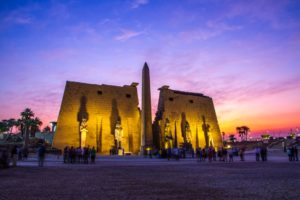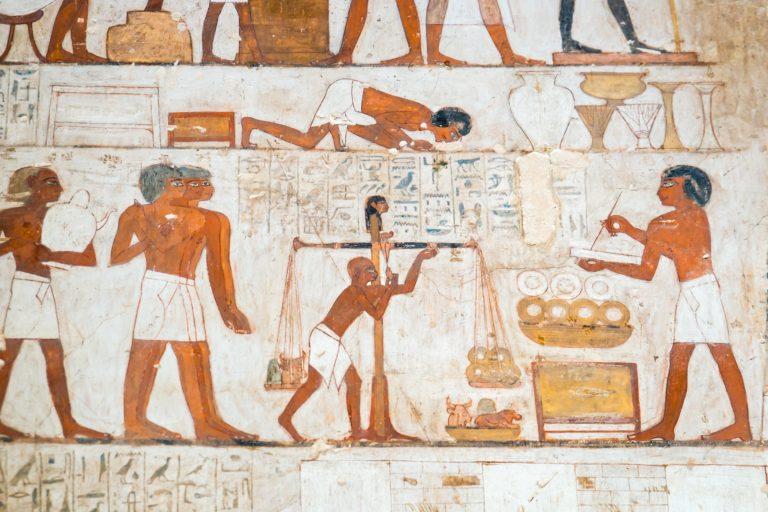The City of Esna: A Journey Through Time
Esna is a living time capsule of Egypt
Esna, known as Latopolis in Greek, is located on the Nile River’s west bank, approximately 60 kilometers south of Luxor. Esna is a popular stopover for visitors traveling between Luxor and Aswan on Nile River cruises. The town’s temple and local market provide a look into ancient Egyptian history and culture. Esna reveals its true essence when explored on foot. Embark on a journey through time, and allow your mind to wander as you wander through the quaint lanes of Esna. Each street holds its own tale, woven over thousands of years.

Layers Of Heritage And Traditional
Esna has a rich past in its distinctive social structure; the city center is partitioned into physical districts inhabited by firmly established Esna families, and its traditional crafts, many of which are on the verge of extinction, have been practiced since the medieval period. Other ancient sites and structures in Esna date back to various times, such as Wekalet Al-Geddawy, an Ottoman caravanserai founded in the 18th century by the ruler Hassan El-Geddawy and named after him. It is one of three caravansaries in Egypt’s south and the only one that has retained its distinctive original design. The Wekala was one of the most significant trading centers in southern Egypt in the 18th century, with traders from all over Africa passing via the west desert and the Red Sea, and it serves as a witness to the power of commerce and Esna’s strategic position as a trade center at the time. The structure was once used for the sale of livestock, vegetables, and crafts.

The ancient market is one of the few remaining marketplaces in southern Egypt, and it is noteworthy for its role in Esna’s local life. The market sells household goods, local crafts, and bridal items.

The El-Amry Minaret is the only surviving structure from the old mosque of the same name, which was demolished and rebuilt in a contemporary form in the 1960s. Badr El-Deen Gamaly constructed the mosque between the years 474 and 476 Hijri (1081 to 1084 AD), making it the first mosque constructed in Esna during the Fatimid era. The Bakour family has owned the oil press for more than 200 years, and it is the only one still standing in Esna.

Esna’s Coptic period was noted for its resistance to Roman oppression. The Martyrs’ Monastery was constructed in the sixth century. The monastery is noteworthy to Christians since it was founded by Saint Helena following a war between Romans and Coptic Egyptians that resulted in the deaths of 3600 martyrs during the period of Christian persecution in Egypt. The fight was commanded by Diocletian, the Roman emperor, who launched an offensive against Christians in Egypt. On the day of the Martyrs’ Massacre, an attack began, prompting the Bishop of the city of Esna, Father Ammonius, to escape with the whole Christian population to the monastery to hide from the emperor’s army, but they were ultimately discovered and slain.
Luxor Tours & Activities
Looking to save some costs on your travel? Why not join a shared group tour to explore Luxor, Egypt? Here are some activities you might be interested in:
When approaching its temple, a visitor notices the roof first because the temple still stands on the original ground level, whereas the modern town rises 9 meters higher, on top of the remnants of the ancient town and its descendants, which have grown up around the temple over the last 2,000 years. There is no proof of the village of Esna and its temple prior to the Middle Kingdom, but from this point on, we have source materials up to the end of ancient Egyptian history. In Graeco-Roman times, the town’s temple was one of several temples and shrines in the Esna area. These additional ecclesiastical constructions were all demolished between the Middle Ages and the twentieth century. Even the temple at Esna is only partially intact. The outside hypostyle hall (pronaos) is still standing, but the main structure (naos), which was previously located behind it, has nearly vanished.

The pronaos of the Esna temple are remarkable, with elegant capitals from twenty-four columns supporting the ceiling. The ornamentation consists of over 230 scenes, the majority of which depict the king making sacrifices to the deities, as well as slaughtering their opponents and even dancing for them. The ceiling also features some amazing celestial depictions. The Ptolemies, notably Ptolemies VI and VIII and their sister Cleopatra II, decorated the back wall of the pronaos, which had previously served as the temple’s façade (naos). The inscriptions and reliefs on the three other walls come from Roman times, and they bear the names of the majority of the emperors who reigned between Claudius and Decius.
Al-Qīsāriyya Market
The public open space between the Khnum Temple and the al-‘Amriyya Minaret served as Esna’s central plaza. Historic photographs of Esna show this location as the city’s primary marketplace. The Wekalet Al-Geddawy caravanserai, one of the city’s important trading buildings, is also on this plaza. To the north and south of the square, AL-Qīsāriyya Street continued parallel to the Nile for over 1.5 kilometers. The street is named after Esna’s famous AL-Qīsāriyya market. Qīsāriyyas, an urban market type, is thought to have existed since Roman times, probably since the period of the Roman emperor Augustus Caesar (63 B.C.–14 A.D.). They are made up of a long and narrow covered roadway, or often a network of streets, that run through the heart of a city.

On both sides of the street, there are two- and three-story buildings; businesses and workshops are located on the ground level, with direct access to the street. Upper levels offer dwelling spaces, which are occasionally used by traders visiting the city. There are wakālas (caravansaries) along this street. Textiles, spices, and traditional attire are common items sold in such street marketplaces. Many Upper Egyptian cities, like Asyut, Sohag, Qena, and Esna, still have Qīsāriyyas that serve as popular local marketplaces. Esna’s Al-Qīsāriyya Market is a popular destination for both visitors and locals. It serves as a regional commerce hub, facilitating a variety of economic activities. Textiles, clothes, housewares, haberdashery, tailoring, upholstery, and other commodities are among the items covered. As a result, it is a popular location for newlyweds and families planning their weddings.

Esna’s Qīsāriyya Market has two main components. The northern half begins in Wekalet Al-Geddawy, passes by the Church of Mother Dūlāji, and continues northward. It becomes livelier on its northern side, which is covered with contemporary components, due to its proximity to Esna’s public transit center. There are numerous architecturally notable structures along this stretch of roadway that date back to the turn of the twentieth century. The façade of Bayt al-Shabrāwī, completed in 1874, is located in a tiny alleyway and features elaborate ornate burned brick and woodwork. On Saturdays, the northern half of AL-Qīsāriyya becomes even more vibrant as it joins with Esna’s weekly Saturday Market, known for local food and clay crockery.

The southern section begins on the south side of the Khnum Temple. This portion is quieter. It retains its traditional wooden cover and is flanked by mud-brick structures with traditional elements such as colorful wooden doors. This covered market spans over 130 m from the Khnum Temple area to Esna’s attractions, including the traditional Bakkūr Oil Press, the Church of the Blessed Virgin Mary, and numerous architecturally notable structures. There are around 120 local stores, predominantly traditional tailors creating clothing such as jalbiyyas and sell textiles, including women’s traditional fabrics and shawls unique to Esna, such as al-Ḥabra, al-Farkha, and al-Nishra. The southern section of AL-Qīsāriyya Market still has the ruins of a traditional wakāla, accessible through one of the textile stores. The market’s traditional wooden canopy, together with its north-south orientation, produces a nice wind.
Esna Lock

The Old Esna lock was constructed during the reign of Khedive Abbas Hilmi II in 1908, and underwent renovations before reopening on January 1st, 1996. The lock measures 221 meters in length, 17 meters in width, and 14.6 meters in depth, with an elevation difference of 8 meters. The lock’s body comprises seven joints, each measuring 20.6 meters long. Impressively, it features two entrances, a front entrance measuring 32 meters, and a back entrance measuring 29.3 meters. The lock’s construction involved the use of 40-meter-deep diaphragm walls, with a bridge placed on top of the walls.

The lock’s operation begins when a boat enters and the lock gates close behind it. The water level inside the lock is then adjusted until it matches the downstream water level, a process that balances the water levels. The downstream gates are then opened, allowing the boat to continue downstream. The lock’s filling and emptying mechanisms are facilitated through the use of four mechanical gates. A control tower oversees the opening and loading of the lock, with the entire process taking approximately 6 minutes to complete.
F.A.Q
The Temple of Khnum, also known as the Temple of Esna, is located in the town of Esna.






